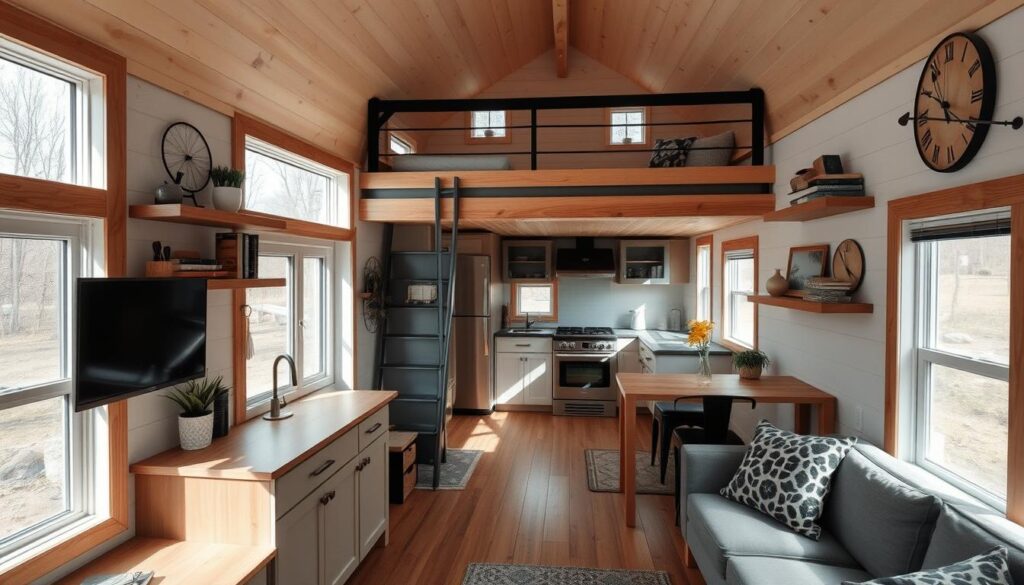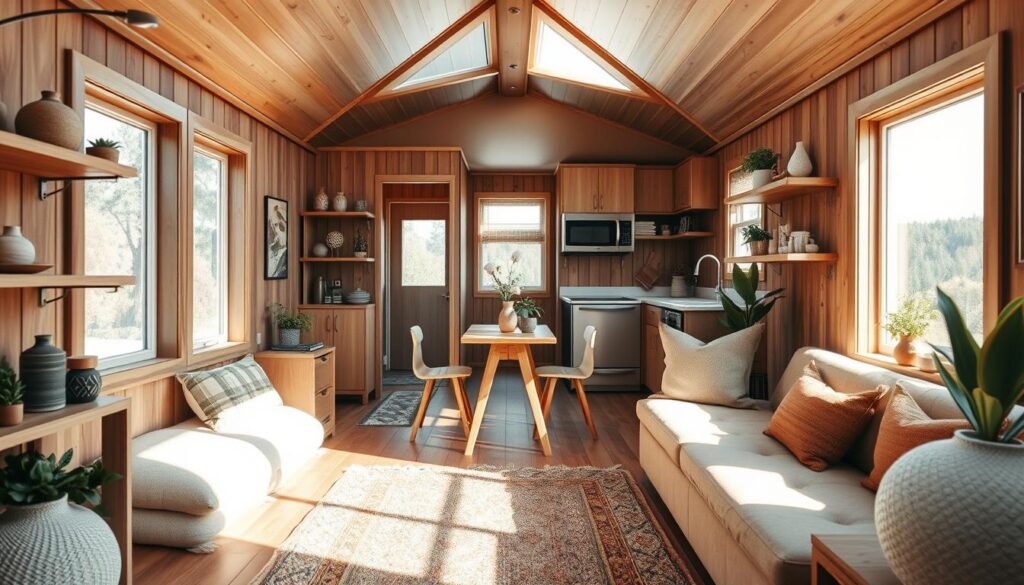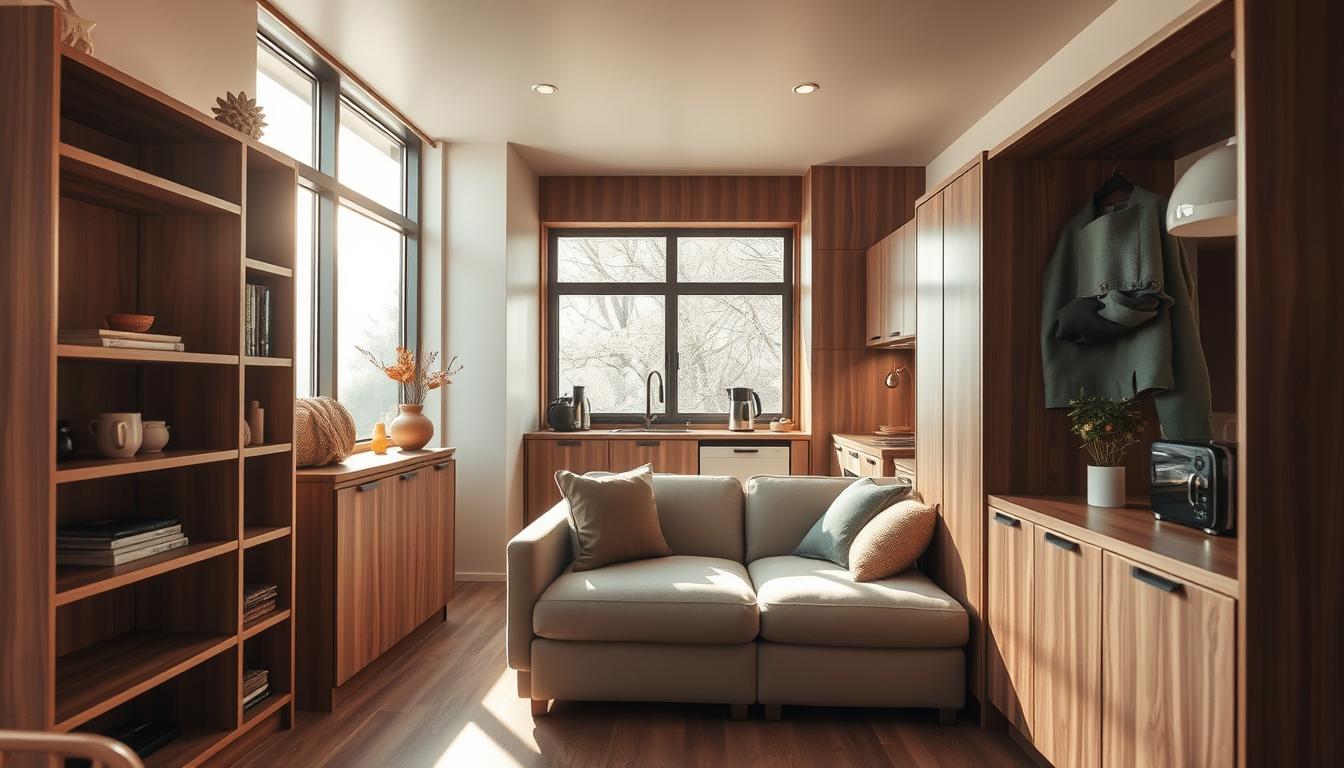Did you know the average person spends about $1,300 a year on storage? This is because many of us have cluttered living spaces. With the growing trend of small space design, it’s key to use every inch wisely. We’ll dive into the world of tiny home interior design to share vital tips for a tidy and useful space.
We’ll give you useful tips and ideas to optimize your space, no matter its size or shape. By using these strategies, you can have a more organized, cozy, and serene home.
Key Takeaways
- Effective strategies for maximizing small spaces
- Practical tips for creating a clutter-free living area
- Ideas for improving the functionality of your space
- Ways to enhance the comfort and peace of your living environment
- Essential design principles for small space design
Understanding Tiny Home Interiors
At the heart of tiny home design is the idea of using space wisely and keeping things simple. This makes small homes more livable and supports a minimalist living lifestyle.
Tiny homes are more than just small spaces. They show a choice for simplicity and efficiency. To get what tiny home interiors are all about, we need to look at their key traits and design elements.
What Defines a Tiny Home?
A tiny home is small, usually under 500 square feet. This size means every detail must be thought out carefully. Important parts include:
- Compact footprint
- Efficient use of space
- Simple, uncluttered design
- Sustainable materials and practices
Key Features of Tiny Home Design
Tiny home design has some key features that make living there better and more functional. These are:
- Multi-functional furniture that does more than one thing, cutting down on the need for lots of items.
- Vertical space utilization, using walls for storage and shelves.
- Open floor plans that make rooms feel bigger and improve movement.
These elements help make the most of the space and lead to a tidy and calm home. As we dive deeper into tiny homes, it’s clear that tiny house decor is key in making a home that looks good and works well.
Understanding the design principles behind tiny homes helps homeowners create spaces that are both efficient and stylish. These spaces also show off the homeowner’s personal taste.
Importance of Space Optimization
In tiny homes, making the most of every inch is vital for a better life. It helps create a tidy, useful, and beautiful home. This is essential for compact living, where every bit of space matters.
Optimizing space is more than just comfort. It’s about living in a way that’s good for the planet and enjoyable. Done right, it makes your home more efficient and eco-friendly.
Benefits of Maximizing Interior Space
Maximizing space in tiny homes brings many benefits. Some key advantages include:
- Increased functionality through efficient layout planning
- Improved mental well-being due to reduced clutter and stress
- Enhanced overall quality of life through better utilization of available space
By using space-saving solutions, you can turn your home into a space that works well for you. It won’t feel cramped or messy.
How Space Affects Lifestyle
The way you use space in a tiny home greatly affects your life. A well-designed space can make you feel calm and organized. But a bad design can make you feel trapped and stressed.
| Aspect | Optimized Space | Poorly Optimized Space |
|---|---|---|
| Mental Well-being | Reduced stress, improved calmness | Increased stress, feelings of claustrophobia |
| Functionality | Highly functional, efficient | Limited functionality, inefficient |
| Quality of Life | Enhanced quality of life | Reduced quality of life |
Understanding the importance of space optimization is key. It helps tiny home dwellers make better choices for their living space. This leads to a more comfortable and sustainable compact living experience.
Clever Storage Solutions
Effective storage is key in tiny homes, where every inch matters. To keep a cozy interior and ensure tiny home organization, clever storage is essential. These solutions help keep things tidy and make your home peaceful.
Multi-Functional Furniture
Using multi-functional furniture is a smart way to save space in tiny homes. Items like storage ottomans, sofa beds, and coffee tables with storage can do many things. They reduce the need for extra furniture and save space.
For example, a storage ottoman can be a footrest, extra seat, and storage for linens or toys. A murphy bed can fold up against the wall, making room for other activities.
Hidden Storage Ideas
Hidden storage is a clever way to stay organized in tiny homes. You can use storage under beds, inside walls, and behind decorations. For instance, bed risers or storage bins under the bed can hold out-of-season clothes or bedding.
Also, installing shelves or cabinets that look like part of the wall can hide storage. This keeps your home looking good while staying organized.
Vertical Space Utilization
Using vertical space is vital in tiny homes, where floor space is limited. Shelves, hanging organizers, or storage units that reach the ceiling can greatly increase storage. This keeps things organized and makes your home feel bigger.
For example, wall-mounted shelves for books, decorations, or kitchen tools can clear surfaces. Hanging organizers behind doors add storage for jackets, bags, or cleaning supplies.
By using these smart storage ideas, you can have a tidy, cozy interior in your tiny home. Good tiny home organization makes the most of your space and improves your living experience.
Layout Planning for Functionality
A well-designed layout is key for tiny homes. It’s important to think about how each area will work together. This ensures your tiny home is both functional and comfortable.
Choosing between an open floor plan or defined spaces is a big decision. Open floor plans make your home feel bigger. They’re great for socializing because they merge living, dining, and kitchen areas into one space.
Open Floor Plans vs. Defined Spaces
Open floor plans have many benefits for tiny homes:
- They make the space feel larger
- They improve natural light distribution
- They enhance social interaction
Defined spaces, on the other hand, offer privacy. They help separate areas like a bedroom or home office.
As Forbes points out, finding a balance between openness and defined spaces is crucial.
“A well-designed tiny home should make you feel like you’re getting the best of both worlds – the freedom of openness and the coziness of defined areas.”
Traffic Flow Considerations
Good traffic flow is essential in layout planning. It ensures easy movement through your tiny home. This prevents feeling cramped or blocked.
| Traffic Flow Considerations | Benefits |
|---|---|
| Clear Pathways | Reduces clutter and improves navigation |
| Strategic Furniture Placement | Enhances flow and functionality |
| Minimal Obstructions | Creates a sense of openness and spaciousness |

By planning your layout well, you can achieve a functional and cozy tiny home. Consider both open floor plans and defined spaces, along with traffic flow. This way, your home will meet your needs perfectly.
Emphasizing Natural Light
Using natural light is a great way to make a tiny home feel bigger. It brightens the space and tricks the eye into seeing more room. This is key for minimalist living.
Window Placement Strategies
Where we put windows is very important. We should aim for spots that get lots of sunlight. This might mean bigger windows or more of them in the right places.
Also, think about how your tiny home faces. South-facing windows get more sun than north-facing ones. Knowing this helps us place windows for the best light.
Using Mirrors Effectively
Mirrors are a smart space-saving solution. They reflect light and make rooms seem bigger. Place mirrors opposite windows to spread light around and brighten the room.
Mirrors also make a tiny home feel roomier. They add depth and make the space seem more open. This trick fits well with minimalist living.
Color Schemes and Decor
In tiny homes, choosing colors and decor is key. It makes the space feel bigger, cozier, and welcoming. A good color scheme and decor can transform a small area into a cozy retreat.
The Psychology of Color in Small Spaces
Colors affect our mood and how we see space. In tiny homes, picking colors that feel open and calm is crucial. Light colors on walls and ceilings can make a room seem larger. Dark colors can add depth as accents.
“The choice of color is not just about personal preference; it’s also about creating an atmosphere.”
| Color | Psychological Effect | Ideal Use in Tiny Homes |
|---|---|---|
| White | Creates a sense of openness and cleanliness | Walls, ceilings |
| Light Blues and Greens | Promotes calmness and serenity | Accent walls, bedding |
| Dark Grays and Browns | Adds depth and warmth | Furniture, decor accents |
Choosing the Right Décor Style
Your tiny home’s décor should show your personality and be practical. Look for furniture and decor that does more than one thing. For a cozy interior, add warm lighting, soft textures, and inviting colors.

Think about the look you want for your decor. For a modern vibe, go for simple designs, less ornamentation, and focus on function.
- Select furniture that fits your tiny home’s size.
- Use mirrors to make rooms seem bigger.
- Add plants for a natural touch and freshness.
By carefully picking colors and decor, you can make your tiny home beautiful, functional, and comfy. This way, you achieve the perfect tiny house decor.
Kitchen Design in Tiny Homes
Designing a kitchen for a tiny home needs careful planning and creativity. We must use every inch of space to make a cooking area that works well and is efficient.
In small living spaces, the kitchen is more than just for cooking. It’s often the center of the home. So, it’s important to make it functional and stylish.
Essential Features of a Tiny Kitchen
There are key features to think about in tiny home kitchens:
- Efficient Layout: A good layout is essential. It should make moving around and working in the kitchen easy.
- Multi-Functional Elements: Using elements that do more than one thing can really help the kitchen’s usefulness.
- Ample Storage: Storage is crucial in tiny kitchens. Using vertical space and hidden spots can keep things tidy.
Space-Saving Appliances
Choosing the right appliances is key in a tiny kitchen. We suggest picking models that save space but still work well.
- Compact Refrigerators: These fit into small spaces but still offer plenty of storage.
- Two-in-One Appliances: Appliances that do two things, like a microwave-convection oven combo, are very handy.
- Induction Cooktops: These save space and are also energy-efficient and safer than gas stoves.
By using these features and appliances, we can make a tiny home kitchen that’s both useful and fun to cook in.
Personalizing Your Tiny Home
Making your tiny home your own is about finding a balance. It’s about creating a space that meets your needs and shows your personality. We’ll look at how to achieve this balance.
Incorporating Personal Touches
Adding personal touches to your tiny home makes it feel more like home. You can do this by displaying personal items, choosing colors that you love, or adding textures for warmth.
For example, you can show off family photos, artwork, or collectibles on shelves or walls. Using multi-functional furniture helps keep things organized and clutter-free. Check out Modern Interior for more tiny home design ideas.
“The way you personalize your space can greatly impact how you feel within it. It’s not just about aesthetics; it’s about creating an environment that nurtures your well-being.”
Balancing Style with Functionality
In tiny homes, it’s key to balance style and function. You want your space to look good and work well. Choosing furniture that is both stylish and functional is a good way to do this.
| Furniture | Style | Functionality |
|---|---|---|
| Sofa Bed | Modern Design | Sleeping and Seating |
| Storage Ottoman | Minimalist | Storage and Seating |
| Drop-Leaf Table | Compact | Dining and Workspace |
By picking furniture and decor that balance style and function, you can make a tiny home that looks great and works well.
Maintaining a Clutter-Free Environment
Keeping your tiny home clutter-free is key. Every inch matters. Simple habits and strategies can make your living space peaceful and stress-free.
Effective Daily Routines
Daily routines are vital for a tidy tiny home. Set aside time each day to clean up. Always put things back after use. This habit greatly helps in keeping your space organized.
Simplifying Your Belongings
Downsizing is crucial. Sort your items into keep, donate, and discard piles. Choose multi-functional furniture and hidden storage for space-saving. Simplifying your belongings makes your tiny home more efficient.
These strategies help keep your tiny home clutter-free. They make the most of your space-saving solutions.



